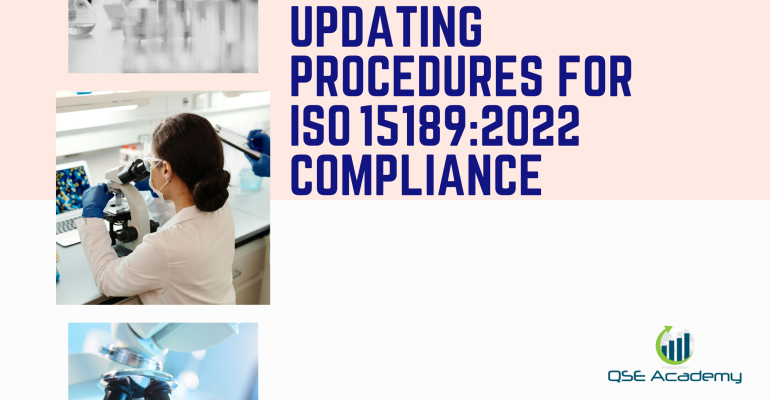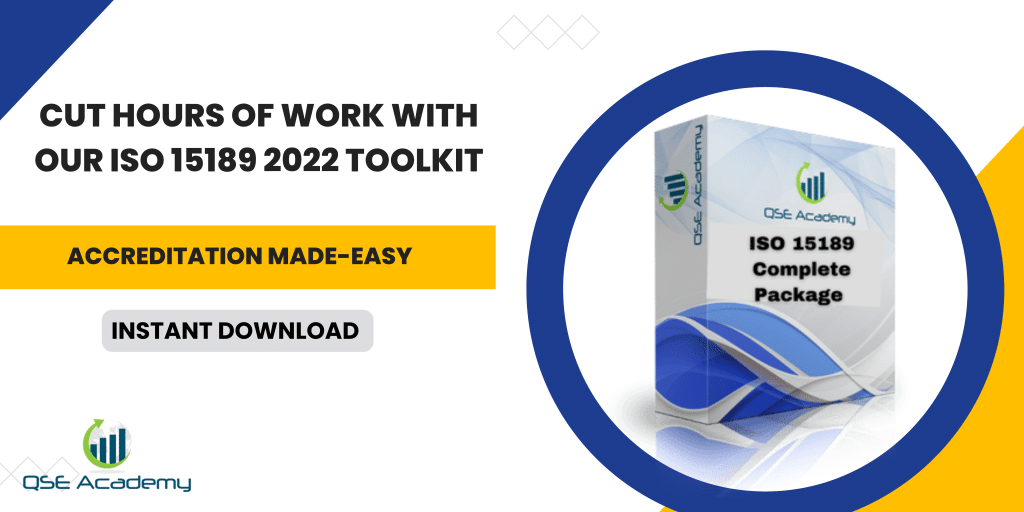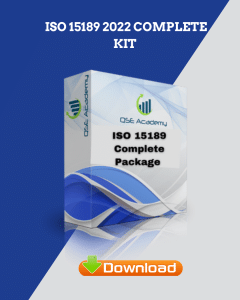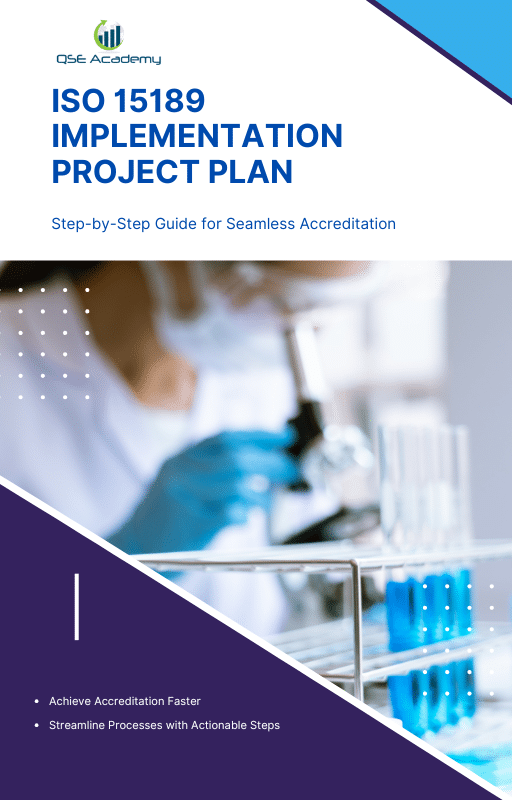Updating Procedures for ISO 15189:2022 Compliance
Last Updated on October 22, 2025 by Hafsa J.
Why Updating Procedures Matters in the ISO 15189:2022 Transition
When ISO 15189:2022 was released, a lot of laboratories assumed their existing procedures would only need minor tweaks. After all, “quality is quality,” right? Unfortunately, that’s where many labs get caught.
I’ve helped labs across Asia and the Middle East go through this exact update, and here’s what I’ve seen every time: what worked under ISO 15189:2012 doesn’t always meet the intent of the 2022 version.
The new standard expects laboratories to demonstrate competence and control, not just document them. That means your procedures can’t simply tell people what to do — they need to explain why each step ensures reliable, safe, and impartial results.
Updating your procedures isn’t about rewriting everything from scratch. It’s about modernizing your system to fit today’s way of working — digital tools, automated instruments, and risk-based management.
When done right, those updates make your processes leaner, your audits smoother, and your staff more confident.
By the end of this guide, you’ll know:
-
Which procedures need updates under ISO 15189:2022
-
How to realign them efficiently
-
How to make each one “audit-proof” while staying practical for everyday use
Pro Tip: Don’t rush to reissue every SOP. Start by identifying which procedures directly support patient safety, data integrity, or staff competence — those deserve attention first.
Understanding What Changed – How ISO 15189:2022 Reshaped Documentation
Before you start updating your procedures, you need to understand why the 2022 version changed the game.
ISO 15189:2022 didn’t just reorganize clauses—it redefined how laboratories are expected to think about quality and competence.
The old 2012 structure was heavily procedural. It focused on “having” documents that described processes. The 2022 version goes deeper. It asks labs to prove that their procedures are not only written but effective in practice.
Here’s the big shift:
-
The standard now emphasizes outcomes over paperwork.
-
Risk and opportunity management are built into the system, not treated as separate checklists.
-
Documentation should reflect real operations, not idealized versions of them.
In short, ISO 15189:2022 expects you to write procedures that show control, awareness, and intent.
Example:
Under the 2012 standard, you might have a generic procedure for “Equipment Calibration.”
Under 2022, that same procedure needs to explain how calibration results are reviewed, what risks uncalibrated instruments pose to patient results, and how competence is verified for staff performing the checks.
Pro Tip: When reviewing your existing documents, ask one simple question:
“Does this procedure demonstrate understanding, or does it just describe a task?”
That distinction tells you whether it’s aligned with the 2022 intent.
Common Mistake:
Many labs still treat documentation as a compliance exercise. The new standard rewards clarity, not volume. If a procedure doesn’t add control or prevent error, it probably doesn’t need to exist.
Step-by-Step Approach to Updating Laboratory Procedures
If you’ve ever updated your quality system before, you know how easy it is to get lost in the paperwork. ISO 15189:2022 makes that even trickier because it shifts from “document everything” to “document what matters.”
Here’s a straightforward approach I use when guiding labs through the update.
Step 1. Identify Impacted Procedures
Start by listing all your existing procedures.
Then, highlight the ones linked to Clauses 5 through 8 of the new standard—these are the ones most affected.
Focus first on high-risk or high-impact areas: testing processes, data handling, equipment calibration, and competence management.
Pro Tip: Don’t just rely on your document list. Sit with section heads—they often know where “unwritten practices” exist that now need to be formalized.
Step 2. Map Old Clauses to the New Structure
Use a simple clause correlation matrix to track where your old 2012 requirements fit into the 2022 structure.
This is where you’ll start noticing shifts in meaning.
For instance, some technical requirements moved under “resources” and “processes,” while management requirements are now grouped under Clause 8.
This mapping saves you from rewriting procedures unnecessarily—it helps you update only what has changed in intent.
Step 3. Evaluate Each Procedure’s Relevance
Once you’ve mapped everything, ask: “Does this procedure still serve a purpose?”
Some older documents may no longer be needed, especially if they describe tasks that are now covered by software or automated systems.
Common Mistake: Keeping every old SOP “just in case.” Redundant procedures create confusion during audits and waste training time.
Step 4. Rewrite with Risk-Based Thinking
For every procedure you keep, review it through a risk lens.
Identify what could go wrong in that process, how you control it, and what evidence shows the control works.
Example:
In a specimen handling SOP, add a note describing risks of mislabeling and how barcoding minimizes that risk. It’s a simple line, but it demonstrates understanding and control—exactly what auditors look for under 2022.
Step 5. Review, Approve, and Communicate
Once updated, route each document through your approval workflow.
Involve both technical and quality representatives—they’ll catch gaps the other might miss.
Then, make sure staff are aware of the changes. A signed acknowledgment or short briefing record is enough to prove awareness during an audit.
Pro Tip: Keep a “Procedure Update Log.” It tracks version changes, reasons for revision, and links to the relevant ISO 15189:2022 clauses. Assessors love seeing that—it shows structured control.
Updating procedures this way keeps your QMS lean, relevant, and audit-ready. You’re not just editing text—you’re building a smarter system that aligns with how your lab actually operates.
Key Procedure Areas That Must Be Updated
When you start aligning your documentation with ISO 15189:2022, you’ll notice that not every procedure needs a full rewrite.
But some areas absolutely do—because the expectations have changed significantly.
If you focus on these first, you’ll cover most of what auditors now look for during the transition.
1. Personnel Competence and Training
The 2022 version puts competence front and center.
It’s not enough to prove that staff were trained—you must show they’re continually competent and impartial in their work.
That means your training and competence procedure needs to include:
-
Regular evaluations and observed performance checks
-
How impartiality risks are identified and managed
-
How retraining or corrective actions are triggered after errors
Pro Tip: Link your competence records to audit findings and risk assessments. It shows assessors that you manage performance based on evidence, not routine.
2. Information Management Systems (LIS or LIMS)
ISO 15189:2022 treats information systems as part of your laboratory’s infrastructure, not a background tool.
Your Information Management Procedure now needs to cover:
-
Validation of software and data interfaces
-
Data integrity and backup testing
-
Access control and traceability
-
Security and confidentiality of electronic records
Common Mistake: Many labs rely on their IT department to handle this separately. But the lab is ultimately responsible for showing the system supports accuracy and confidentiality.
3. Risk and Opportunity Management
This is a new mindset for many labs.
You’ll either need a dedicated Risk Management Procedure or integrated risk sections in your key SOPs.
It should explain how risks are identified, assessed, controlled, and reviewed.
Example: Add a “Risk Considerations” section in your pre-analytical, analytical, and post-analytical procedures to show how patient safety is protected at each stage.
4. Equipment Calibration and Maintenance
Your equipment procedures should now demonstrate more than maintenance schedules—they need to show traceability and validation of software-based instruments.
Describe how measurement uncertainty and calibration intervals are determined, not just recorded.
Pro Tip: Include verification steps for automated systems and explain how updates are validated after servicing or software changes.
5. Management Review and Internal Audit
Clause 8 now expects management reviews and internal audits to feed into continual improvement.
Update your management review and audit procedures to include inputs like:
-
Risk and opportunity outcomes
-
Competence review results
-
Information management issues
-
Supplier and customer feedback trends
Common Mistake: Copying last year’s management review agenda. Auditors expect to see that the review evolved to match the 2022 structure.
6. Confidentiality and Patient Safety
Patient safety is no longer implied—it’s explicitly embedded in multiple clauses.
Review your confidentiality and ethics procedures to include how you handle data protection in electronic systems, sample traceability, and communication with clinical teams.
Pro Tip: Map where patient data flows across departments and document how each step protects privacy. That visual alone can impress assessors.
These six procedure areas represent the core of ISO 15189:2022’s new direction—competence, impartiality, digital control, and patient-centered outcomes.
If you modernize these first, the rest of your documentation updates will fall neatly into place.
Writing Style & Structure for ISO 15189:2022 Procedures
Here’s something I’ve noticed after reviewing hundreds of laboratory SOPs:
The procedures that pass audits smoothly aren’t the ones with the most pages — they’re the ones that are clear, purposeful, and easy to follow.
ISO 15189:2022 rewards clarity and understanding. Your documents don’t have to sound academic; they just need to show control and competence.
Keep Procedures Short and Structured
Every procedure should be concise and structured around why things are done, not just how.
A simple, modern layout works best:
-
Purpose – Why this procedure exists and what it controls
-
Scope – Where it applies and who it affects
-
Responsibilities – Who does what
-
Procedure Steps – The sequence of actions, with risk or rationale notes where needed
-
Risk Considerations – What could go wrong and how it’s prevented
-
Records & References – What evidence or forms are linked to this activity
This layout mirrors the intent of ISO 15189:2022 — to connect your daily operations with risk-based, outcome-driven thinking.
Make the Language Practical
Avoid writing procedures like policy manuals.
Use simple, direct sentences that staff can follow without re-reading.
Example:
Instead of:
“Personnel shall be adequately trained prior to the execution of assigned tasks.”
Write:
“All staff must complete method training and pass observation before performing the test independently.”
See the difference? It sounds human, but it still meets auditor expectations.
Add Rationale Where It Matters
The 2022 edition is big on demonstrating understanding.
When you include a short rationale beside a critical control step, it shows auditors that your team doesn’t just follow instructions — they understand why.
Example:
“Verify centrifuge speed before use. This prevents hemolysis and ensures accurate plasma separation.”
That single sentence proves both technical control and competence.
Be Consistent Across All Documents
Once you choose a structure, stick to it.
Inconsistency confuses staff and frustrates auditors. Make sure all your procedures follow the same template, font, version format, and approval layout.
Pro Tip: Add a “Linked Clause” line in each procedure footer. It’s a small detail, but it makes traceability to ISO 15189:2022 clear during assessments.
Use Visuals Where They Add Clarity
If a process involves decision points or sequences, include a simple flowchart or diagram.
Assessors and staff both appreciate visual clarity, especially for complex analytical or data processes.
When your procedures are written this way, you don’t just show compliance — you make your quality system usable, teachable, and audit-proof.
Document Control & Change Management
Here’s the truth: even the best-written procedure can fail you if it isn’t controlled properly.
ISO 15189:2022 expects laboratories to demonstrate not only that documents are current, but that every change is intentional, reviewed, and communicated.
Document control isn’t paperwork — it’s proof that your system is stable.
Track Every Version with Purpose
Each procedure should clearly show its revision number, date, and reason for change.
That “reason for change” field is more important than many labs realize — it tells assessors that updates weren’t random but driven by a quality need.
Example:
“Revised to align with ISO 15189:2022 Clause 6.2 – added competence evaluation section.”
That single line shows awareness of the new requirement and builds immediate auditor confidence.
Pro Tip: Keep a “Master Document List” that includes a column for linked ISO clause. It turns your list into an instant audit reference tool.
Review and Approve Before Issue
Every update must go through the proper approval workflow — typically, a technical reviewer, a quality representative, and final authorization by the lab director or QA manager.
Don’t skip steps just because a revision seems small. Even minor updates can change how a process functions or how records are interpreted.
Common Mistake: Allowing section heads to edit procedures directly in shared folders without formal review. That’s a guaranteed nonconformity under the new system.
Communicate and Train on Every Change
Once a procedure is approved, staff must be informed — and that communication must be documented.
Training can be as simple as a short briefing or email acknowledgment, as long as there’s evidence that the team understood the change.
Pro Tip: Maintain a “Procedure Change Log” that records:
-
Document name and number
-
Summary of change
-
Date communicated
-
Names or signatures of trained staff
This shows assessors that your laboratory doesn’t just issue documents — it manages change effectively.
Archive Obsolete Documents
Don’t delete old versions; archive them.
ISO 15189:2022 still requires traceability, especially when auditors review older records or incidents that occurred before the transition.
Label them clearly as Superseded and keep them accessible only to the quality team.
When your document-control process is disciplined, your entire QMS feels consistent and credible.
Assessors won’t have to question which version is current — they’ll see that every change has purpose, control, and accountability behind it.
Practical Example – Updating a Competence Procedure
Let’s make this real.
One of the biggest updates in ISO 15189:2022 is how laboratories manage competence and impartiality.
Under the 2012 version, most labs focused on keeping training records — who attended what course, on what date, and who signed it off. That was fine back then, but the new version wants more than proof of training. It wants proof of performance.
Here’s how you can update your existing competence-assessment procedure to meet the 2022 expectations.
Old Approach (2012 Style)
-
Purpose: To ensure all staff are trained for assigned tasks.
-
Records: Training attendance logs, certificates, and checklists.
-
Assessment: Conducted once after initial training.
The weakness here? It focuses on participation, not demonstrated skill. Once someone completed training, they were automatically considered competent—until an audit finding proved otherwise.
New Approach (2022-Compliant Style)
Purpose: To ensure ongoing competence and impartial performance of laboratory personnel in accordance with ISO 15189:2022 Clause 6.2.
Key Additions:
-
Performance Evaluation: Include regular observation, proficiency test participation, and error review as part of competence evidence.
-
Impartiality Checks: Add a section on identifying and managing conflicts of interest—for example, when staff validate results for tests they also perform.
-
Risk Awareness: Incorporate a short risk statement explaining how competence errors can affect patient safety or result accuracy.
-
Corrective Actions: Define clear steps for retraining, re-evaluation, and documentation when competence gaps are found.
Example Rewrite Snippet
Old Text:
“The Quality Manager ensures all staff complete training prior to performing independent work.”
Revised Text:
“The Quality Manager ensures all staff demonstrate competence through direct observation and performance evaluation before performing independent work.
Competence is re-evaluated annually or following any identified performance concern. Records include observation notes, test review outcomes, and retraining documentation.”
That short revision covers the key intent of ISO 15189:2022 — control, verification, and continuous improvement.
Pro Tip:
Add a small table at the end of the procedure linking it to ISO 15189:2022 clauses and related SOPs (e.g., training records, risk register, audit procedure).
It shows assessors that your system is interconnected, not a collection of standalone documents.
By modernizing your competence procedure this way, you demonstrate exactly what the 2022 edition demands — that your laboratory doesn’t just train staff, it develops and verifies their competence continuously.
FAQs – Updating Procedures for ISO 15189:2022
When laboratories start updating procedures for ISO 15189:2022, the same few questions come up every time.
Here are clear, experience-based answers that should save you a few headaches along the way.
Q1: Do we need to rewrite every procedure from scratch?
No, and you shouldn’t.
Start with what already works — your 2012 procedures are still a solid foundation. The goal is to realign, not reinvent.
Review each one to see if it meets the intent of the new clauses. If it does, you can simply revise and add new sections for risk, competence, or information management.
Pro Tip: Focus on impact. If a procedure influences patient safety, impartiality, or data integrity, update it first.
Q2: Who should approve revised procedures?
Follow your established document-control process.
Typically, that means technical supervisors or section heads review for accuracy, while your quality manager or laboratory director gives final approval.
However, make sure at least one reviewer fully understands ISO 15189:2022.
It’s not about signing off — it’s about confirming that every change aligns with the new intent of the standard.
Q3: What format should we use for new procedures?
You can keep your existing template, as long as it’s consistent and controlled.
Just make sure to add these two modern features:
-
A “Risk Considerations” section after the steps.
-
A “Clause Reference” line showing which ISO 15189:2022 requirement it supports.
These additions make your documents instantly audit-friendly and traceable.
Q4: How often should we review procedures after the update?
ISO 15189:2022 expects procedures to stay current and effective, not just “on file.”
Review each document at least once a year, or sooner if:
-
You change equipment or software.
-
You identify errors or trends through internal audits.
-
You receive updated guidance from your accreditation body.
Common Mistake: Waiting until the audit year to review everything at once. That approach causes rushed updates and training gaps.
Keeping your procedures aligned with ISO 15189:2022 isn’t a one-time project — it’s a cycle of review, improvement, and communication.
When your documentation reflects how your lab really works, compliance becomes the natural outcome, not a scramble before audit day.
From Paperwork to Proof of Competence
Updating your procedures for ISO 15189:2022 isn’t about chasing new paperwork — it’s about proving that your laboratory operates with awareness, control, and purpose.
The new standard shifts the spotlight from “Do you have a procedure?” to “Does your procedure work, and can you prove it?”
In my experience, laboratories that treat documentation updates as a learning process — not a compliance task — end up with stronger systems and more confident teams.
Their SOPs actually guide daily work, not just sit in folders waiting for audits.
If you take one thing from this guide, make it this:
Every updated procedure should show understanding — of risk, of competence, and of patient safety.
That’s what auditors look for. And more importantly, that’s what builds trust in your results.
So start small:
-
Identify your top 10 high-impact procedures.
-
Update them using the 2022 intent — competence, impartiality, data integrity, and risk awareness.
-
Train your team, record the change, and move on to the next set.
Within weeks, you’ll have a leaner, more reliable quality system that works as hard as your lab does.
If you’d like to make the process faster, QSE Academy’s ISO 15189:2022 Procedure Update Toolkit gives you ready-to-use templates and clause mapping guides — built specifically to help labs transition smoothly and pass their audits confidently.
Whether it’s ISO 9001, ISO 22000, or the cosmetics-focused ISO 22716, I’ve spent my career I’m not here to call myself an expert—I prefer “enthusiast” because I truly love what I do. When I’m not writing about standards, you’ll probably find me playing Piano 🎹, connecting with people, or diving into my next big project💫. I’m an engineer specialized in the food and agricultural industry
make ISO standards less intimidating and more approachable for everyone.
turning complex jargon into clear, actionable steps that businesses can actually use.
There’s something incredibly rewarding about helping people navigate food safety and quality management systems
in a way that feels simple, practical, and even enjoyable.
I have a Master’s in QHSE management and over 12 years of experience as a Quality Manager
I’ve helped more than 15 companies implement ISO 9001, ISO 22000, ISO 22716, GMP, and other standards
My clients include food producers, cosmetics manufacturers, laboratories, and service companies
I believe quality systems should be simple, useful, and efficient.













